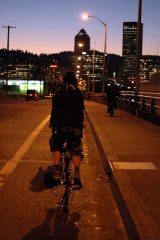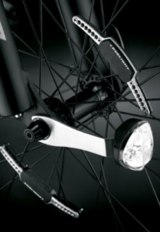
[This article was written by contributor Elly Blue. You can read more from Ms. Blue here.]
“Do not ride at night,” urges the Huffy Bicycle Company website. “Have someone pick you up if you’re out after dark or walk your bike home.”
This attitude is fortunately not the norm in Portland, where ever-increasing numbers of cyclists ride year-round and bike light education and/or giveaway programs abound.
You’ve got to have bike lights here. This becomes more obvious every time you encounter an unlit biker at night.

(Photo � J. Maus)
Bike lights are also the law in Oregon — white in front, red in the rear, both reasonably visible. (A red reflector is legally adequate in the rear, but in practice it isn’t visible to anyone on bike or foot, or in a car that’s approaching from the side.)
Lights are still a problem, though, even for those who already have them and are committed to using them.
Battery-powered, plastic-encased blinking lights (a.k.a. “blinkies”) are the norm, but maintaining them can be a real headache.
You get caught out at night without them. You forget to turn them on. Someone steals them when you run into the grocery store and you have to spend $20-50 bucks on a new set. You drop them and the casing shatters. The bulbs burn out. The batteries fade in the middle of a long ride. Or they run out after being on in your bag all day.
“Lights should be built into bicycles as a matter of course…not as accessories, but as indispensable, functional parts of the bike.”
We’ve all figured out ways to get around this, like investing in rechargeable batteries, sturdier lights, and better mounting systems, or attaching the lights to your helmet so you never forget to bring them — but the costs still add up, and keeping the batteries fresh and the lights handy is a constant pain in the neck.
Recent public education efforts about the importance of lights are important (and effective). But these campaigns will be an uphill battle until we have a shift in attitudes about bike lights that includes the industry and bike shops as well.
In the United States, bike lights are still perceived as an accessory at best; at worst — like on Huffy’s web site — their existence is not even acknowledged. Lights should be built into bicycles as a matter of course, or at least sold along with them in the way that wheels, brakes, and handlebars are — not as accessories but as indispensable, functional parts of the bike.

In my quest to solve the Great Bike Light Problem, I recently sprang for a set of Reelights (available locally Clever Cycles on Hawthorne). They’re powered by magnets that you attach to your spokes, so there are no batteries to contend with, and they mount on with your wheels so you don’t need to ever remove them or even turn them on and off. The basic model is $45, which is comparable to what you can spend on a set of battery-powered blinkies, minus the batteries.
The Reelights aren’t perfect — they’re too low to the ground and not as bright as I’d like, so I’m thinking about attaching a second set of lights to my helmet again, or at least carrying a spare red blinky for the worst rainy-dark-trafficky nights. I’d like to look into hub-powered lights in the future.
It’s surprisingly relaxing to be able to just get on my bike and go without thinking about lights.
Most of us probably just see bike lights as a necessary but minor daily annoyance. But now that I’ve discovered this genre of built-in lights, I’m amazed that solutions like these aren’t the norm in this country.
Huffy Bicycle Company may not yet take it for granted that their products are used by adults for transportation, at night as well as during the day. But attitudes are beginning to shift among the general population and in the rest of the bike industry.
I hope that a similar change happens with our attitudes about lights. With more people riding (often unlit) than ever before, and with the dark season upon us, it’s a change that can’t happen soon enough.
What are your experiences with various lighting set-ups? Do you have tips for readers that are new to riding at night?

